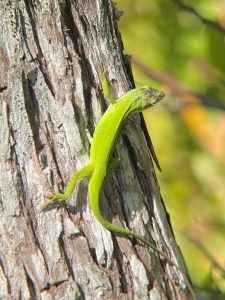Some are legless, while others are lengthy and quite large! They may be lackluster or lavishly colored, and love to laze in warm sunny spots. Florida is a land of many lizards, and here in Sarasota, there is a diverse bunch of interesting animals to get to know!
In this blog, learn a few native and non-native species of lizards that you can find in our county. You can also learn more about Sarasota’s other fascinating species of wildlife by checking out the Wild Sarasota blog series, or watching our Wild Sarasota webinars on our Florida Wildlife webpage.
What Makes a Lizard a Lizard?
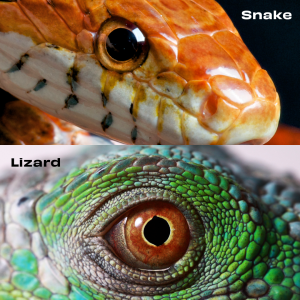
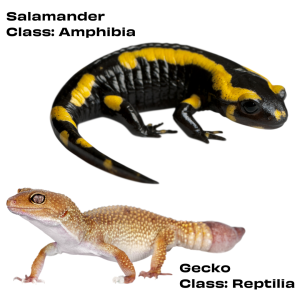
Iguanas, geckos, chameleons, Komodo dragons, and tegus, oh my! Though they go by many names, these animals are all lizards. Scientifically speaking, a lizard is a scaly-skinned, ectothermic reptile belonging to the order Squamata.
While the order Squamata also includes snakes, what we recognize as lizards are further separated into the suborder Sauria. They generally differ from snakes in the possession of legs, movable eyelids, and external earholes. However, nature does not always fit into a nice little box. There are some exceptions amongst lizards, as you will soon discover!
You may have heard people refer to alligators as big lizards, but they are actually more closely related to birds than to lizards and snakes!
Salamanders and newts are sometimes caught up in the lizard mix as well. These interesting animals may have a physical shape that resembles that of a lizard, but they are amphibians rather than reptiles. Amphibians differ significantly in their physiology, lifecycle, and more!
Some of Sarasota’s Native Lizard Species
The Green Anole (Anolis carolinensis)
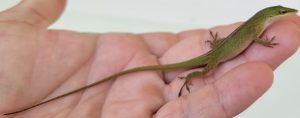 The green anole is the only species of anole that is native to the state of Florida. Their bright green coloration allows them to seamlessly camouflage with the foliage of trees and plants. There is some evidence that suggests that green anoles will move higher into the tree canopy to avoid non-native brown anoles, which compete with them for habitat and resources (Murray, 2021). Landscaping with a range of native plants, shrubs, and trees that grow to different heights is one thing that we can do to help ensure that green anoles have a chance to thrive.
The green anole is the only species of anole that is native to the state of Florida. Their bright green coloration allows them to seamlessly camouflage with the foliage of trees and plants. There is some evidence that suggests that green anoles will move higher into the tree canopy to avoid non-native brown anoles, which compete with them for habitat and resources (Murray, 2021). Landscaping with a range of native plants, shrubs, and trees that grow to different heights is one thing that we can do to help ensure that green anoles have a chance to thrive.
Though they are called green anoles, these small, slender lizards can also turn brown to camouflage with their surroundings, when temperatures drop, and even based on their emotional state and stress levels (Carmichael & Williams, 2016). Green anoles generally reach sizes of around 5 to 8 inches in length. Males will extend a light pink-colored dewlap or throat fan, to attract females or as a territorial display amongst other males.
The Southeastern Five-lined Skink (Eumeces inexpectatus)
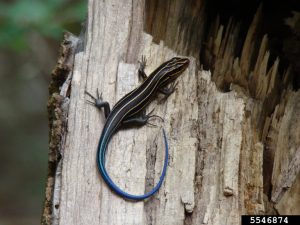
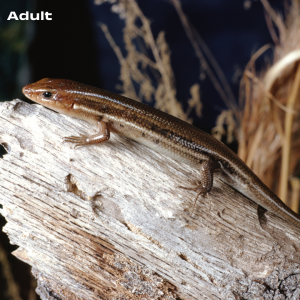
These fascinating lizards have a wide neck and unique way of moving that quickly gives away their identity. Their interesting bodies appear shiny and almost metallic in color. Five-lined skinks can be found quickly and alertly hunting for prey on the ground.
They have characteristic lines running down the length of their body, and adults generally have a reddish-brown colored head. Some individuals retain the electric blue tail that they possess as juveniles. Southeastern five-lined skinks can grow up to 8.5 inches long.
The Eastern Glass Lizard (Ophisaurus ventralis)
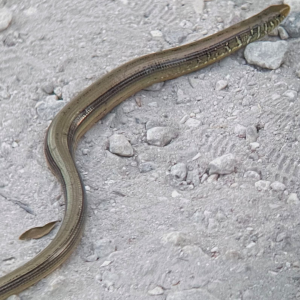
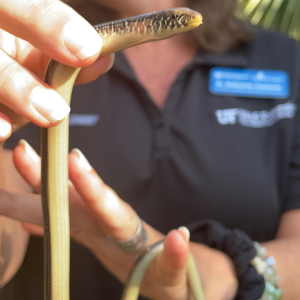 Remember when I said that nature doesn’t always fit into a neat little box? Enter the Eastern glass lizard. Most lizards are distinguished from snakes due to their legs, but Florida’s 4 species of glass lizards (and 1 species of worm lizard) are exceptions.
Remember when I said that nature doesn’t always fit into a neat little box? Enter the Eastern glass lizard. Most lizards are distinguished from snakes due to their legs, but Florida’s 4 species of glass lizards (and 1 species of worm lizard) are exceptions.
The Eastern glass lizard is the most commonly encountered legless lizard, and can grow just over 3ft. in length! Though at first glance their body shape may resemble that of a snake’s, their movements are much less smooth. Other clues that give away this lizard’s identity are its eyelids, external earholes, and snout/head shape. When threatened, glass lizards are able to quickly break off their tails. The detached tail will continue to wriggle around, tricking predators into thinking they have captured a meal.
A Few Non-native Lizards Found in Sarasota County
The Brown Anole (Anolis sagrei)
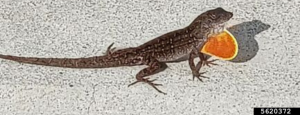
Brown anoles are native to Cuba and the Bahamas. They have become one of the most commonly seen and recognized lizard species in Florida. Males have bright reddish-orange and yellow dewlaps. Individuals of this species vary in shades of brown, tan, and black, and have a variety of patterns and markings on their bodies. Some may even have orange heads.
The Knight Anole (Anolis equestris)

Although less common than brown anoles, knight anoles have been recorded in Sarasota County. These green lizards can be distinguished from native green anoles by their larger size and large head, yellow markings, and rougher skin.
The Northern Curly-tailed Lizard (Leiocephalus carinatus)
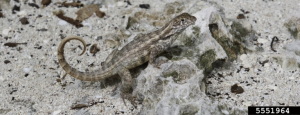
Northern curly-tailed lizards are native to Cuba, the Cayman Islands, and the Bahamas. They were introduced into Florida to consume sugar cane pest insects (Marchese, 2020). As their name describes, these lizards will lift and curl their tail when approached.
Geckos (Gekkonidae)
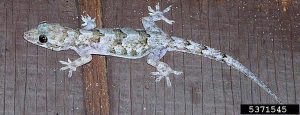
The most commonly seen non-native geckos in Sarasota are various species of house geckos (Hemidactylus spp.). They are mostly nocturnal, and can be seen feeding on insects on walls near lighting fixtures. Geckos are another type of lizard that does not follow the usual “lizard versus snake” rules- most geckos do not have movable eyelids!
The Florida reef gecko is Florida’s only native species of gecko. They are very small, and found in far Southeastern Florida and the Keys.
The Black Spiny-tailed Iguana (Ctenosaura similis)

This species of lizard can inhabit the burrows of threatened gopher tortoises. Additionally, black spiny-tailed iguanas may also eat the eggs and young of native bird species, sea turtles, and gopher tortoises. As juveniles, they are green. Males can reach up to 4ft. in length.
The Brown Basilisk (Basiliscus vittatus)
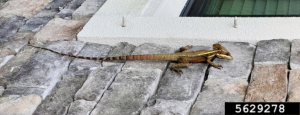
Sightings of this non-native lizard have been recorded in Sarasota County. Brown basilisks found their way into Florida through the pet trade (Gioeli et al., 2022) and are being monitored for their impacts on Florida’s ecosystems.
Reporting Critical Non-native and Invasive Species
Invasive species can have significant impacts on native flora and fauna. They can even cause damage to our economy and may spread diseases that can impact humans and native wildlife. Many invasive species end up in Florida through intentional and accidental releases of pets into the wild. It is important to never release unwanted pets into the environment. Always keep pets in proper enclosures that will not allow them to escape. Report sightings of non-native animals to the Early Detection and Distribution Mapping System (EDDMapS), or to the IveGot1 Mobile App. You can also report all nonnative snakes, monitor lizards, and tegus to FWC’s Invasive Species Hotline.
Learn More
I hope that this guide to some of Sarasota’s lizard species has helped you identify some of the unique critters that you may have seen around town, or piqued your interest in these fascinating animals. Learn more about lizards and Sarasota’s other wildlife with the resources below.
- Florida Amphibians and Reptiles
- Exotic Reptiles and Amphibians
- Lizard sightings in Sarasota County
- Brown basilisks
- Black spiny-tailed iguanas
- Florida Wildlife
- Wild Sarasota Blog Series
Sources
Carmichael, P. & Williams, W. (2016). Florida’s Fabulous Reptiles and Amphibians (15th ed.). World Publications.
Gioeli, K. T., Johnson, S. A., & Thompson, A. (2022). Brown Basilisks in Florida. EDIS. https://doi.org/10.32473/edis-UW497-2022.
Marchese, H. (2020, April 27). Florida lizard’s bad case of constipation makes history. Florida Museum. https://www.floridamuseum.ufl.edu/science/florida-lizard-record-breaking-constipation/.
Murray, S. (2021, October 7). UF Study: Where brown anoles invade, native green anoles reach new heights. UF/IFAS Blogs. https://blogs.ifas.ufl.edu/news/2021/10/07/uf-study-where-brown-anoles-invade-native-green-anoles-reach-new-heights/.
 2
2
